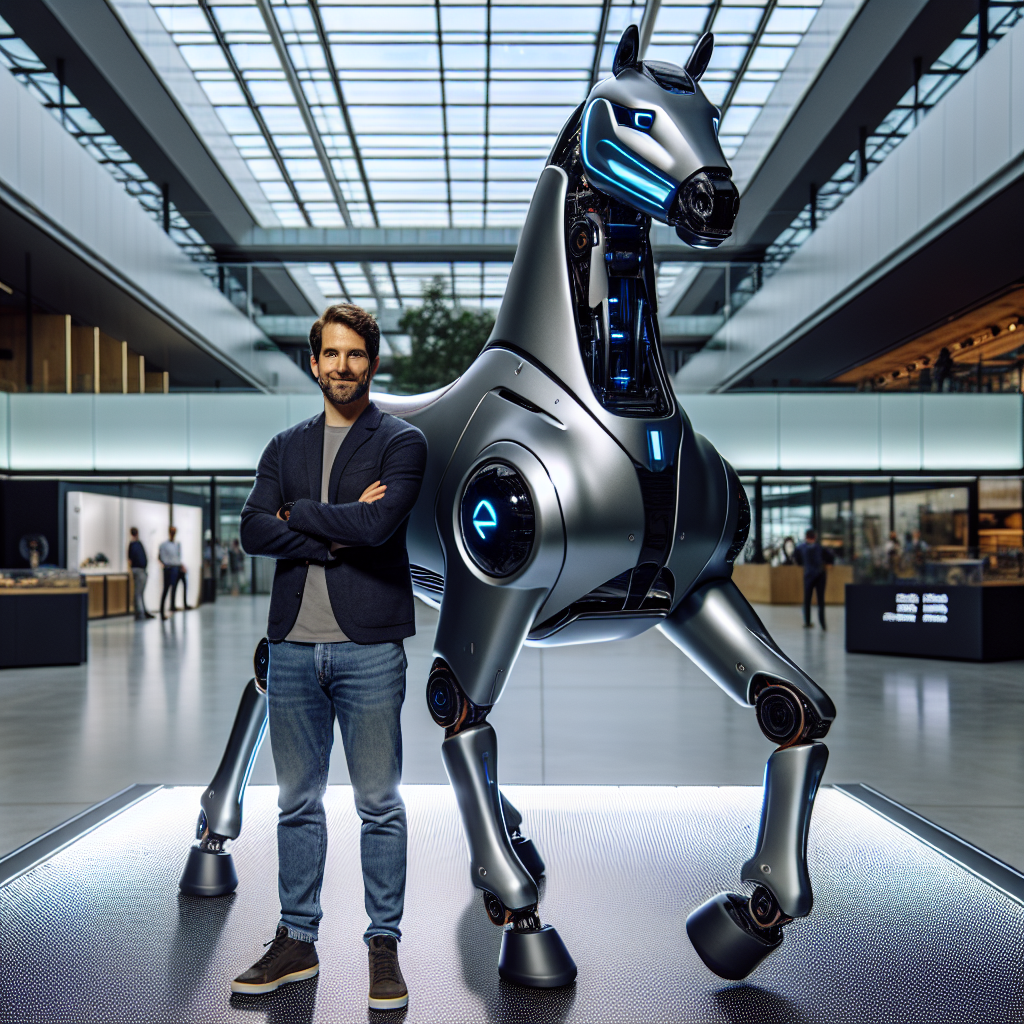
Kawasaki Unveils Innovative Rideable Robot Horse Revolutionizing Robotics
In a stunning leap forward for robotics technology, Kawasaki Heavy Industries has introduced a remarkable new creation that blends cutting-edge engineering with nostalgic design. Their rideable robot horse, named “Bex,” represents a bold new direction in the field of mechanical mobility. This fascinating development might just reshape our expectations about personal transportation and robotic assistants.
The Mechanical Steed: What Is Bex?
Kawasaki’s Bex is a quadrupedal robot designed to carry human passengers. Unlike traditional robots focused purely on utility, Bex combines function with an appealing aesthetic inspired by the ibex mountain goat. The robot stands out with its distinctive horned head and goat-like appearance.
The robot can carry up to 220 pounds (100 kg), making it suitable for transporting an adult rider. Moreover, Bex can switch between walking on four legs and rolling on wheels, giving it incredible versatility across different terrains. This dual-mobility system allows the robot to navigate complex environments effectively.
Kawasaki first unveiled Bex at the 2022 International Robot Exhibition in Tokyo, where it quickly became a crowd favorite. Since then, engineers have continued refining its capabilities, resulting in the current version that’s capturing worldwide attention.
Technical Specifications and Capabilities
Bex represents an impressive feat of engineering with several notable features:
- Weight capacity of 220 pounds (100 kg) for carrying riders or cargo
- Hybrid locomotion system allowing both quadrupedal walking and wheeled movement
- Modular upper body design that can be adapted for different applications
- Battery-powered operation for emissions-free use
- Advanced balance systems to ensure rider safety
The robot’s most innovative aspect might be its adaptable movement system. When navigating flat surfaces, Bex can lower its body and roll on wheels for efficient travel. When facing stairs, rough terrain, or obstacles, it can rise up and walk on four legs like an animal.
According to Robotics Business Review, this kind of hybrid mobility represents a significant advancement in robot design, potentially solving many of the challenges that have limited quadrupedal robots in real-world settings.
Beyond Transportation: Modular Design
While the rideable goat form has captured public imagination, Kawasaki emphasizes Bex’s modular design. The upper body can be removed and replaced with different attachments depending on the intended use. This flexibility transforms Bex from a novelty item into a potentially revolutionary work platform.
For instance, the robot could be configured to carry supplies in agricultural settings, transport materials in construction zones, or assist with delivery services in urban environments. The possibilities extend well beyond its eye-catching appearance as a mechanical mount.
The Engineering Challenge Behind Bex
Creating a robot capable of safely carrying human passengers presents significant engineering challenges. Kawasaki’s development team had to solve complex problems related to balance, weight distribution, and power management.
One major hurdle was creating joints and motors powerful enough to support human weight while remaining efficient enough for practical battery life. Additionally, the team needed to develop sophisticated control systems that could maintain stability across different postures and movements.
The company drew on its extensive experience with industrial robotics and motorcycle engineering to overcome these obstacles. This cross-disciplinary approach allowed them to leverage existing knowledge while pushing into new technological territory.
Safety Considerations
Passenger safety naturally became a primary concern for Kawasaki’s engineers. The robot includes multiple fail-safes to prevent accidents, including:
- Stability monitoring systems that continuously adjust joint positions
- Emergency shutdown protocols if unusual movement is detected
- Reinforced rider seating with secure positioning
- Speed limitations to prevent dangerous operation
These safety measures reflect Kawasaki’s understanding that pioneering new forms of human-robot interaction requires exceptional attention to potential risks. The company continues testing and refining these systems before any commercial release.
Applications and Potential Use Cases
Beyond its novelty factor, Bex offers practical applications across numerous industries. Some potential use cases include:
Agriculture and Forestry
In farming and forestry settings, Bex could transport workers across fields or through forests while carrying tools and supplies. Its ability to navigate uneven terrain makes it especially valuable in these environments. Additionally, different upper-body attachments could convert it into specialized equipment for tasks like monitoring crops or light harvesting.
Industrial Facilities
Large industrial complexes often require workers to travel significant distances while carrying equipment. Bex could serve as an efficient transportation option in these settings. Its compact design allows it to navigate narrow corridors and confined spaces better than traditional vehicles.
Emergency Response and Rescue
The robot’s ability to traverse difficult terrain could prove valuable in emergency scenarios. Rescue teams might use modified versions to reach victims in areas inaccessible to conventional vehicles. Similarly, it could deliver medical supplies or equipment to remote locations during disaster response operations.
Entertainment and Tourism
Perhaps the most immediately appealing application lies in entertainment and tourism. Theme parks, resorts, and tourist destinations could offer rides on these robotic mounts as unique attractions. The novelty of riding a mechanical horse would likely draw significant interest from visitors seeking unusual experiences.
Market Position and Competition
Kawasaki enters an increasingly competitive field of advanced robotics. Companies like Boston Dynamics have already established strong positions with quadrupedal robots such as Spot. However, Bex differentiates itself through its passenger-carrying capabilities and hybrid locomotion system.
The robot also benefits from Kawasaki’s established manufacturing infrastructure and engineering expertise. This industrial backing gives the company advantages in scaling production and ensuring reliability compared to smaller robotics startups.
Industry analysts suggest the global market for service robots will exceed $37 billion by 2025, according to the International Federation of Robotics. Passenger-carrying robots like Bex could capture a significant portion of this growing market if they prove practical and cost-effective.
Cultural Impact and Public Reception
Public response to Bex has been overwhelmingly positive, with videos of the robot accumulating millions of views online. The design seems to tap into both futuristic fascination and nostalgic connection to animal mounts that have served humanity for millennia.
This cultural resonance may prove crucial to market acceptance. Unlike purely utilitarian robots that can appear threatening or alien, Bex’s animal-inspired design creates immediate emotional connection. People understand intuitively how to interact with something resembling a horse or goat, even if it’s mechanical.
Some commentators have noted connections to science fiction and fantasy media featuring mechanical mounts. From the “Star Wars” speeder bikes to mechanical horses in various anime series, the concept has established cultural precedents that make Bex seem both revolutionary and familiar simultaneously.
Future Development and Commercial Availability
Kawasaki has not yet announced specific timeline for commercial availability or pricing for Bex. Industry experts expect continued refinement before any consumer version becomes available. The current prototype demonstrates the concept’s feasibility, but mass production would require further engineering optimization.
Potential hurdles to commercialization include:
- Battery life optimization for practical daily use
- Manufacturing cost reduction
- Regulatory approvals for passenger transport
- Development of intuitive control systems for non-expert users
Despite these challenges, Kawasaki’s strong position in industrial manufacturing and robotics suggests they have the resources to bring Bex to market if consumer interest remains strong. The company has established a dedicated robotics division that continues advancing the technology.
The Broader Implications for Robotics
Bex represents more than just an interesting product – it signals important shifts in robotic design philosophy. By creating machines that complement human physical capabilities rather than simply automating tasks, Kawasaki points toward a future where robots and humans form more integrated partnerships.
This approach contrasts with industrial robots designed to replace human labor entirely. Instead, Bex augments human capabilities, enabling people to travel farther, carry more, and access difficult terrain more easily. This complementary design philosophy could reshape expectations about human-robot relationships.
Furthermore, the robot’s biomimetic design—drawing inspiration from natural forms—demonstrates the continuing value of looking to evolution for engineering solutions. Animals have developed efficient movement systems over millions of years, and robots like Bex leverage this natural research and development.
Conclusion: A New Chapter in Human-Robot Interaction
Kawasaki’s rideable robot horse represents a fascinating convergence of advanced technology and intuitive design. By creating a robot that humans can physically ride and interact with, the company pushes robotics into more intimate territory than most industrial or service applications.
Whether Bex ultimately succeeds as a commercial product or remains primarily a technological demonstration, it has already accomplished something significant: capturing imagination and making people reconsider what robots might become in our daily lives.
As development continues, we may soon see these mechanical steeds not as science fiction curiosities but as practical tools enhancing human mobility and capability. Kawasaki’s innovation suggests that the future of robotics might be less about replacing humans and more about giving us new ways to move through and experience the world.
What do you think about riding a robot horse? Would you try one if given the opportunity? Share your thoughts in the comments below!


